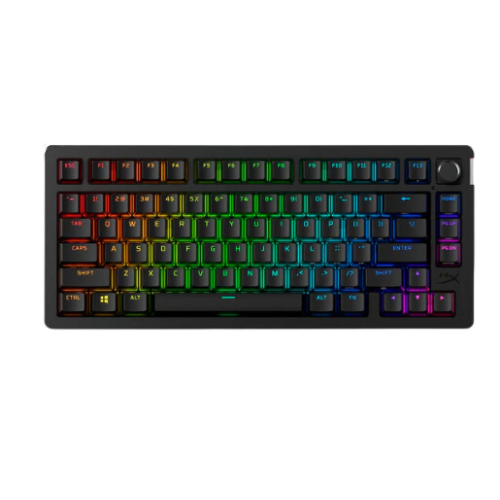This Compact Keyboard Has Some Software Bugs, but I Still Love It
Video Games
Summary
- The HyperX Alloy Rise 75 offers extensive customization options for a personalized typing and gaming experience.
- Impressive battery life of up to 1,500 hours or 80 hours with RGB backlighting keeps players gaming for longer.
- NGENUITY software may cause a bug that keeps the keyboard from being able to use customizable RGB features.
After reviewing so many keyboards, I’m not easily impressed. So, HyperX must have done something right for its Alloy Rise 75 Wireless Keyboard to join the ranks of one of my favorites. Even an annoying software bug wasn’t enough to make me set down the simple but satisfying board.


HyperX Alloy Rise 75 Wireless
The HyperX Alloy Rise 75 is a dream for users who love customization. Swap out the top magnetic plate, change the volume control, and completely alter all key inputs to create the typing and gaming experience that fits your needs. An impressive battery life keeps you playing, while three modes of connectivity allow you to swap seamlessly between devices.
- A bounty of customization options
- Impressive battery life
- Low-latency performance
- Hot-swappable switches
- NGENUITY software may bug the keyboard
- New badges and top plates cost extra
- Costly compared to similar options
- Creamier keys would better accommodate gaming
Price and Availability
The HyperX Alloy Rise 75 Wireless Keyboard is available via HyperX’s official website for $229.99. A wired version is also available with a detachable USB-C cable for $169.99.
A Smooth, Compact Typing Experience
While I did run the Alloy Rise 75 through the gaming gamut, the keyboard is first and foremost used for typing. I put a lot of keystrokes on the board every day, and much like with gaming, precision and comfort are paramount. Thankfully, not only does every keypress actuate when depressed about halfway, but there’s also enough resistance to prevent incorrect inputs.
The gasket mount and pre-lubed HyperX Red Linear switches lend to very smooth typing, and the keys remain stable and in place, even if you swap the factory PBT keycaps for third-party Cherry MX keycaps. Best of all, the board doesn’t emit a very harsh clack. There’s definitely a click to it, but it’s that soothing middle ground between clacky and creamy. If you prefer a harsher click, like that provided by the Cherry MX Blue switch, or something quieter, the Alloy Rise 75 is customizable with hot-swappable switches.
Being a 75% board, there are, of course, missing keys. HyperX configured the layout well, so nothing feels scrunched, and you don’t lose access to more frequently used keys like Delete. Rather, that’s built into a Function (FN) key combo with the Backspace, which feels like the most logical input.
Designed With Gamers in Mind
When I wasn’t typing away, I did use the Alloy Rise 75 as intended. It’s a pretty solid gaming keyboard. With a 1,000Hz polling rate, there’s no noticeable input delay, even when connected via Bluetooth. In fact, the only pitfall to using any of the three available Bluetooth connections is the lack of NGENUITY app support. You need to switch to a wired or 2.4GHz connection to customize the keyboard, though lighting and other custom settings do work in Bluetooth mode once they’re saved to the hardware.
As with so many gaming keyboards, players enjoy 100% anti-ghosting, giving your fingers the freedom to be all over the board without impeding the intended input. While hidden under the F12 key, the Alloy Rise 75 also has a designated “Game Mode.” When activated, the keyboard deactivates the Windows key, Alt+Tab, Alt+F4, Shift+Tab, and Ctrl+Esc. In the chaos of a firefight, there’s only one worse than slipping on that Windows key: a dead battery.
To keep players gaming longer, HyperX opted for a 6,000mAh rechargeable battery capable of lasting up to 80 hours with RGB backlighting or 1,500 without. As I write this review, I’m on my 8th 8-hour workday since its last charge, and there’s still plenty of juice left for at least two more. HyperX definitely did well when it comes to an extensive battery life.
Some users may feel HyperX could have enhanced the board with Hall Effect switches and customizable actuation and reset points. My Glorious Gaming GMMK 3 was designed with Hall Effect, and I toyed with different actuation points across multiple game genres. Personally, I don’t feel that, from that board to the Alloy Rise 75, there’s enough of a difference to drastically change the gaming experience for casual and competitive players.
A Mostly Customizable Keyboard
There are many customization options available on the Alloy Rise 75. In fact, practically every component can be changed to your liking, from the top plate to the volume control knob. The board also features a magnetic badge on the side. It comes with a standard HyperX logo, but others are available to purchase. I went with a The Legend of Zelda hearts badge, though the mana and health potion or one of the abstract art badges may be my next pick.
RGB backlighting can be adjusted to add your unique flair to the keyboard. With strips on the sides, you’ll also cast a soft glow against your desk for a boost of color. Setting your custom RGB lighting is done through the NGENUITY desktop app (available on Windows only), which lets you blanket the whole board in one color, set a color-changing effect, or even color each key individually if you have the patience. With the ambient light sensor active, the keyboard will determine how bright the backlights should be based on how lit the room is.
All of this works fairly well, save for a rather annoying problem I ran into using the NGENUITY software. Before I get to the bad, though, it’s worth noting that every key can be assigned a unique function or macro. Even if you want to add more FN key combinations, all but the number row is available to be customized. While I appreciate this degree of customization, HyperX has a little work to do before I can fully endorse NGENUITY’s role in customizing the Alloy Rise 75.
NGENUITY Software Is the Biggest Hiccup
I should preface my problems with NGENUITY by clarifying that I’ve used the software before with the Cloud III headphones and the Pulsefire Haste 2 mouse. In both instances, the software worked well. Whether it’s a firmware issue or a compatibility problem with Windows 11, when I first connected the Alloy Rise 75 to NGENUITY, it locked the board’s settings. I could assign custom RGB and key inputs and save them to one of the ten available profiles, but the keyboard wouldn’t recognize the changes. I couldn’t even swap between profiles using the FN key input. I could fix the issue by switching from the 2.4GHz connection to one of the Bluetooth profiles, but you can’t customize the lighting while in Bluetooth mode, so I have to swap back to 2.4GHz or USB.
The only permanent fix was going into my computer’s Dynamic Lighting settings under the Personalization menu and turning off “Use Dynamic Lighting on my devices.” It’s simple enough, but it took a bit of digging to find. I’m also unsure of how this may affect any future devices with lights and if it may cause compatibility problems with the HyperX keyboard.
While trying to find the fix for this, I also discovered that factory resetting the keyboard is done by holding the FN key and Spacebar. In other models, it’s the FN key and Esc. For some reason, this is nowhere in HyperX’s literature.
Should You Buy the HyperX Alloy Rise 75 Wireless Keyboard?
I’ve already integrated the Alloy Rise 75 into my workflow and permanently set aside the Glorious Gaming GMMK 3 Keyboard that was custom-built for me. My board has been equipped with a set of Ghostbusters keycaps, a custom badge, and a bright green RGB backlight that pops against the all-black aesthetic of my office. Though a future keyboard may take its place, HyperX’s Alloy Rise 75 is my new favorite for my workflow and gaming, even with its little software bug.
That said, there’s a question of value when it comes to the Alloy Rise 75. At $229.99, it’s a hefty price to pay for a keyboard that, if you take away its customizability, looks and feels like many others. With near-identical boards like the Keychron Lemokey P1 Pro on the market retailing for $100 less, the decision comes down to the brand and customizability. Is that extra $100 worth it to stay within HyperX’s ecosystem and have a board that is customizable in virtually every way?


HyperX Alloy Rise 75 Wireless
The HyperX Alloy Rise 75 is a dream for users who love customization. Swap out the top magnetic plate, change the volume control, and completely alter all key inputs to create the typing and gaming experience that fits your needs. An impressive battery life keeps you playing, while three modes of connectivity allow you to swap seamlessly between devices.

















